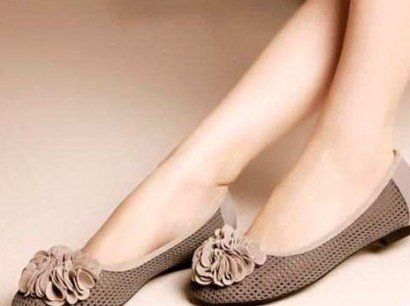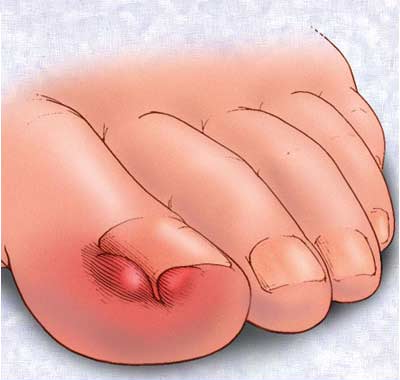How BALLET PUMPS could leave you limping or even missing a toe: Soaring numbers of women are developing ingrown toenails from the shoes, experts warn
 Mike O’Neill, a consultant podiatric surgeon and spokesman for the Society of Chiropodists and Podiatrists, told MailOnline: ‘Ballet pumps put a lot of pressure on a toenail, and the pressure means the nail bends and becomes ingrown. ‘There’s been a big rise in that in the last five years.’ Left untreated, an ingrown toenail can lead to infection of the bone and in a worst case scenario, a person might have to have their toe amputated, he said. It could also lead to infections of the foot, and people have even been known to contract MRSA, he added. He told MailOnline: 'It’s unusual, but in the worst case scenario you could have an infection could go down to the bone – this is called osteomyelitis – then you could have the toe amputated. 'This is more likely to happen in people with diabetes or someone who has bad circulation, whose body can’t fight off infection as readily. 'But anyone who leaves their ingrown toenail untreated could end up in hospital on IV antibiotics. 'People have developed MRSA, and developed secondary infections.' Mr O'Neill said he sees almost 200 ingrown toenails a year, 12 of which are the most severe infected type. These are sometimes a result of too tight shoes or by people cutting their nails and leaving a spike in the corner, which subsequently digs into their skin. Some people, however, are simply more prone to the condition because they were born with nails that naturally curve inwards into the toe, he said. Nails are made of dead skin cells, which are hardened by a protein called keratin. They grow outwards from the half-moon shaped ‘lunala’ at the base of the nail, usually at a rate of 0.1 to 0.2mm a day. They become ingrown if they change shape, become bent, and dig into the flesh at the sides of the nail. Ingrown toenails are categories into stages, which are based on severity, Mr O’Neill explains. Stage 1 toenails, in which the edge of the nail lacerates the skin, often looks as though there is nothing wrong with it, but it hurts in shoes and to touch. Stage 2 - which is most commonly seen in people over 50 - is known as an 'involuted' ingrown toenail. This is where the nail is excessively curved, digging into the skin. This happens if the nail has been being hit, or after a fungal nail infection. Corns and areas of hard skin build up in the borders of the nail, causing pain, and these might become infected. If stage 1 and 2 ingrown toenails are not treated, they can become a stage 3 nail - an infected and inflamed ingrowing toenail, which is the most common. The skin around the nail appears swollen, red and pus may be visible under the skin. Stages 1 – 3 ingrown toenails are acutely painful, Mr O’Neill told MailOnline. He said: ‘Sometimes even lying in bed, touching against pyjamas or the bed clothes can cause pain.’ Surprisingly, the most severe stage – stage 4 – is not painful, Mr O’Neill said. At this stage, the nail is surrounded by granulations tissue, is pussing, discharging and septic,’ he said. ‘But the body turns off the pain mechanism when it gets too tender.’ He often finds people who have this severe type of ingrown toenail who haven’t sought medical help for it in years. He said: ‘When they get as bad as that, there’s usually denial in the patients. There can be a psychosocial problem. 'They could be GP-phobic, or needle-phobic. ‘By the time we’re seeing them they could have been covered in pus and infected for 18 months to two years. ‘People don’t like feet in general, teenage boys tend not to want to show them. ‘Kids hide them from their parents, boys at boarding school hide them from their masters. ‘I had a patient in a few years ago who had done anything about it for two years and he got a new girlfriend and she sent him straight to the doctor to get it sorted out because it was so ugly.’ The treatment for this severe type of ingrown toenail is for a podiatrist to prescribe antibiotics and then perform a procedure known as phenylisation under local anaesthetic. This is where a podiatric surgeon will cut a strip of the nail to the bed, and add the chemical phenyl – a strong alkaline solution - to destroy the nail bed, as well as the bacteria and fungi in the toe. Mr O'Neill's warning over ballet pumps comes after scientists from the University of Nottingham studied the physics of why toenails become ingrown. They came up with the first mathematical formulae that describe how human nails grow. They have discovered that ingrown toenails are caused when the forces holding nails in place, and their rate of growth, become unbalanced. If the balance between adhesion and growth is not balanced, the nail changes shape, and can become ingrown or spoon-shaped. Ingrown nails often occur in children, teenagers and pregnant women, when hormones cause a growth spurt of the nails, which extend into the sensitive flesh alongside them. Cyril Rauch, lead author of the study at the University of Nottingham, told MailOnline big toenails are particularly prone to becoming ingrown because of their shape. 'I’ve never heard of ingrown nails elsewhere apart from the big toe – if that happens it goes beyond physics,' he said. The squareness of the big toe means stress caused by walking is diverted to the tip of the nail, which gets wider to spread the load. Dr Rauch said that people should trim their nails in a ‘parabola shape’ to minimise their chance of getting ingrown nails. He warned that regular poor trimming can tip the fine balance of nails, causing residual stress to occur across the entire nail. ‘We suggest that nail beauty fanatics who trim their nails on a daily basis opt for straight or parabolic edges, as otherwise they may amplify the imbalance of stresses which could lead to a number of serious conditions,’ he said. 'The NHS suggests cutting the nail straight, but you will remove the stress, but you will amplify another stress and that has a tendency to make a trumpet nail, which can become ingrown.' He also warned against the flat, straight, shape popular in salons. 'If you have your nails styled in a French manicure, the nail will be flat, you will amplify the ingrown toenail likelihood,' he said. The research was published in the journal Physical Biology. |

















